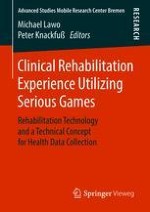2018 | Buch
Clinical Rehabilitation Experience Utilizing Serious Games
Rehabilitation Technology and a Technical Concept for Health Data Collection
herausgegeben von: Prof. Dr. Michael Lawo, Dr. Peter Knackfuß
Verlag: Springer Fachmedien Wiesbaden
Buchreihe : Advanced Studies Mobile Research Center Bremen
